Comprehensive Review on Thin Film Homojunction Solar Cells: Technologies, Progress and Challenges
Abstract
1. Introduction
2. Heterojunction Thin-Film Solar Cells
3. Homojunction Thin-Film Solar Cells
3.1. Perovskite p-n Homojunction
3.1.1. Fundamentals of Perovskite p-n Homojunction
3.1.2. Recent Progress in Perovskite p-n Homojunction
- A.
- Experimental Progress
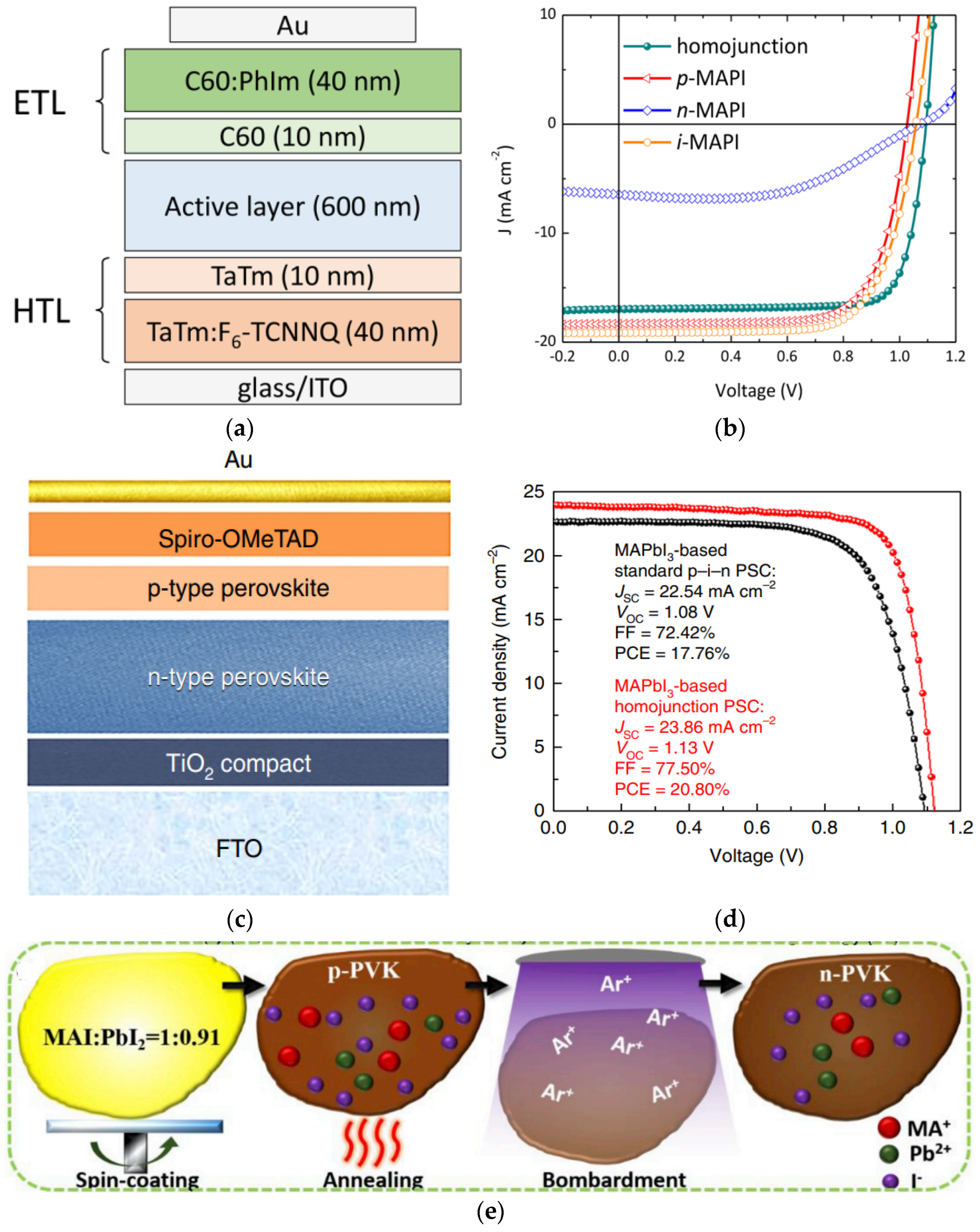
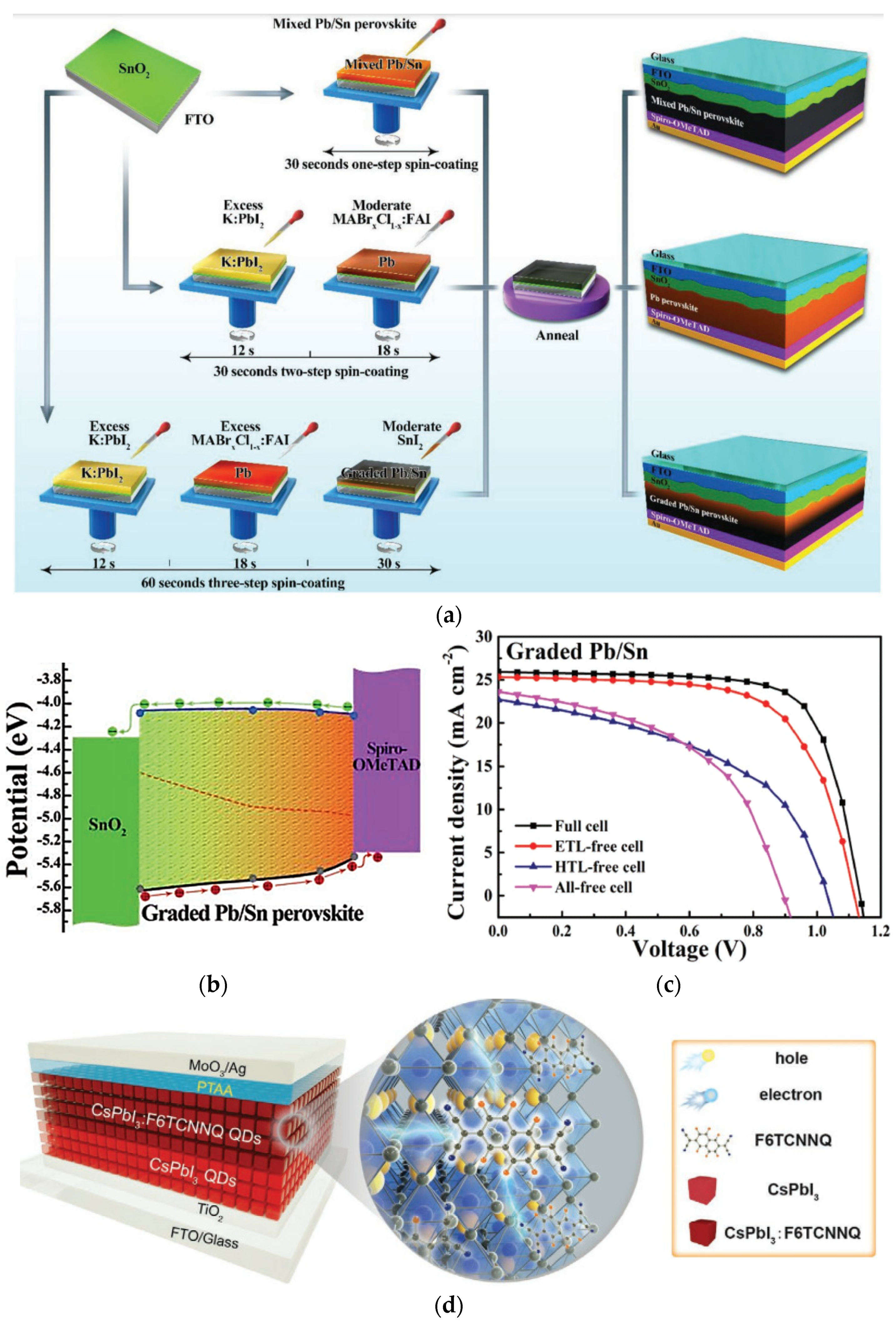
- B.
- Progress in Modeling and Simulation of PVK TFSCs
3.2. Other Candidates for p-n Homojunction
4. Challenges of PVK TFSCs
5. Conclusions
Author Contributions
Funding
Data Availability Statement
Acknowledgments
Conflicts of Interest
References
- Shaker, A.; Salem, M.S.; Deepthi Jayan, K. Analysis and Design of P-n Homojunction Sb2Se3 Solar Cells by Numerical Simulation. Sol. Energy 2022, 242, 276–286. [Google Scholar] [CrossRef]
- Salem, M.S.; Alzahrani, A.J.; Ramadan, R.A.; Alanazi, A.; Shaker, A.; Abouelatta, M.; Gontrand, C.; Elbanna, M.; Zekry, A. Physically Based Analytical Model of Heavily Doped Silicon Wafers Based Proposed Solar Cell Microstructure. IEEE Access 2020, 8, 138898–138906. [Google Scholar] [CrossRef]
- Salem, M.S.; Zekry, A.; Shaker, A.; Abouelatta, M. Design and Simulation of Proposed Low Cost Solar Cell Structures Based on Heavily Doped Silicon Wafers. In Proceedings of the 2016 IEEE 43rd Photovoltaic Specialists Conference (PVSC), IEEE, Portland, OR, USA, 5–10 June 2016; pp. 2393–2397. [Google Scholar]
- Green, M.A.; Dunlop, E.D.; Siefer, G.; Yoshita, M.; Kopidakis, N.; Bothe, K.; Hao, X. Solar Cell Efficiency Tables (Version 61). Prog. Photovolt. Res. Appl. 2023, 31, 3–16. [Google Scholar] [CrossRef]
- Saif, O.M.; Zekry, A.; Shaker, A.; Abouelatta, M.; Saeed, A. Efficient Self-Protected Thin Film c-Si Solar Cell against Reverse-Biasing Condition: A Simulation Study. In Proceedings of the 2022 IEEE 49th Photovoltaics Specialists Conference (PVSC), Philadelphia, PA, USA, 5–10 June 2022; pp. 336–338. [Google Scholar] [CrossRef]
- Lu, S.; Chen, C.; Tang, J. Possible Top Cells for Next-Generation Si-Based Tandem Solar Cells. Front. Optoelectron. 2020, 13, 246–255. [Google Scholar] [CrossRef]
- Nam, D.; Cho, S.; Sim, J.H.; Yang, K.J.; Son, D.H.; Kim, D.H.; Kang, J.K.; Kwon, M.S.; Jeon, C.W.; Cheong, H. Solar Conversion Efficiency and Distribution of ZnS Secondary Phase in Cu2ZnSnS4 Solar Cells. Sol. Energy Mater. Sol. Cells 2016, 149, 226–231. [Google Scholar] [CrossRef]
- Sun, H.; Sun, K.; Huang, J.; Yan, C.; Liu, F.; Park, J.; Pu, A.; Stride, J.A.; Green, M.A.; Hao, X. Efficiency Enhancement of Kesterite Cu2 ZnSnS4 Solar Cells via Solution-Processed Ultrathin Tin Oxide Intermediate Layer at Absorber/Buffer Interface. ACS Appl. Energy Mater. 2018, 1, 154–160. [Google Scholar] [CrossRef]
- Wang, X.; Tang, R.; Jiang, C.; Lian, W.; Ju, H.; Jiang, G.; Li, Z.; Zhu, C.; Chen, T. Manipulating the Electrical Properties of Sb2(S,Se)3 Film for High-Efficiency Solar Cell. Adv. Energy Mater. 2020, 10, 2002341. [Google Scholar] [CrossRef]
- Ren, D.; Chen, S.; Cathelinaud, M.; Liang, G.; Ma, H.; Zhang, X. Fundamental Physical Characterization of Sb2Se3-Based Quasi-Homojunction Thin Film Solar Cells. ACS Appl. Mater. Interfaces 2020, 12, 30572–30583. [Google Scholar] [CrossRef]
- Li, Y.; Huang, W.; Zhao, D.; Wang, L.; Jiao, Z.; Huang, Q.; Wang, P.; Sun, M.; Yuan, G. Recent Progress in Organic Solar Cells: A Review on Materials from Acceptor to Donor. Molecules 2022, 27, 1800. [Google Scholar] [CrossRef]
- Kowsar, A.; Rahaman, M.; Islam, M.S.; Imam, A.Y.; Debnath, S.C.; Sultana, M.; Hoque, M.A.; Sharmin, A.; Mahmood, Z.H.; Farhad, S.F.U. Progress in Major Thin-Film Solar Cells: Growth Technologies, Layer Materials and Efficiencies. Int. J. Renew. Energy Res. 2019, 9, 579–597. [Google Scholar] [CrossRef]
- Nayak, P.K.; Mahesh, S.; Snaith, H.J.; Cahen, D. Photovoltaic Solar Cell Technologies: Analysing the State of the Art. Nat. Rev. Mater. 2019, 4, 269–285. [Google Scholar] [CrossRef]
- Byranvand, M.M.; Otero-Martínez, C.; Ye, J.; Zuo, W.; Manna, L.; Saliba, M.; Hoye, R.L.Z.; Polavarapu, L. Recent Progress in Mixed A-Site Cation Halide Perovskite Thin-Films and Nanocrystals for Solar Cells and Light-Emitting Diodes. Adv. Opt. Mater. 2022, 10, 2200423. [Google Scholar] [CrossRef]
- Green, M.A.; Ho-Baillie, A.; Snaith, H.J. The Emergence of Perovskite Solar Cells. Nat. Photonics 2014, 8, 506–514. [Google Scholar] [CrossRef]
- Saki, Z.; Byranvand, M.M.; Taghavinia, N.; Kedia, M.; Saliba, M. Solution-Processed Perovskite Thin-Films: The Journey from Lab- to Large-Scale Solar Cells. Energy Env. Sci. 2021, 14, 5690–5722. [Google Scholar] [CrossRef]
- Saliba, M. Perovskite Solar Cells Must Come of Age: Developing Aging Standards Is Required for Industrialization. Science 2018, 359, 388–389. [Google Scholar] [CrossRef]
- Schmidt-Mende, L.; Dyakonov, V.; Olthof, S.; Ünlü, F.; Lê, K.M.T.; Mathur, S.; Karabanov, A.D.; Lupascu, D.C.; Herz, L.M.; Hinderhofer, A.; et al. Roadmap on Organic–Inorganic Hybrid Perovskite Semiconductors and Devices. APL Mater. 2021, 9, 109202. [Google Scholar] [CrossRef]
- Kojima, A.; Teshima, K.; Shirai, Y.; Miyasaka, T. Organometal Halide Perovskites as Visible-Light Sensitizers for Photovoltaic Cells. J. Am. Chem. Soc. 2009, 131, 6050–6051. [Google Scholar] [CrossRef]
- Min, H.; Lee, D.Y.; Kim, J.; Kim, G.; Lee, K.S.; Kim, J.; Paik, M.J.; Kim, Y.K.; Kim, K.S.; Kim, M.G.; et al. Perovskite Solar Cells with Atomically Coherent Interlayers on SnO2 Electrodes. Nature 2021, 598, 444–450. [Google Scholar] [CrossRef]
- Yoo, J.J.; Seo, G.; Chua, M.R.; Park, T.G.; Lu, Y.; Rotermund, F.; Kim, Y.-K.; Moon, C.S.; Jeon, N.J.; Correa-Baena, J.-P.; et al. Efficient Perovskite Solar Cells via Improved Carrier Management. Nature 2021, 590, 587–593. [Google Scholar] [CrossRef]
- Snaith, H.J. Perovskites: The Emergence of a New Era for Low-Cost, High-Efficiency Solar Cells. J. Phys. Chem. Lett. 2013, 4, 3623–3630. [Google Scholar] [CrossRef]
- Cui, P.; Qu, S.; Zhang, Q.; Liu, B.; Yan, L.; Du, S.; Wang, X.; Huang, H.; Ji, J.; Li, M. Homojunction Perovskite Solar Cells: Opportunities and Challenges. Energy Mater. 2022, 1, 100014. [Google Scholar] [CrossRef]
- Ali, N.; Ahmed, R.; Luo, J.T.; Wang, M.; Kalam, A.; Al-Sehemi, A.G.; Fu, Y.Q. Advances in Nanostructured Homojunction Solar Cells and Photovoltaic Materials. Mater. Sci. Semicond. Process. 2020, 107, 104810. [Google Scholar] [CrossRef]
- Sun, Y.; Chen, W.; Sun, Z. A Mini Review: Constructing Perovskite p-n Homojunction Solar Cells. Chin. Chem. Lett. 2022, 33, 1772–1778. [Google Scholar] [CrossRef]
- Efaz, E.T.; Rhaman, M.M.; Imam, S.A.; Bashar, K.L.; Kabir, F.; Mourtaza, M.E.; Sakib, S.N.; Mozahid, F.A. A Review of Primary Technologies of Thin-Film Solar Cells. Eng. Res. Express 2021, 3, 032001. [Google Scholar] [CrossRef]
- Chopra, K.L.; Paulson, P.D.; Dutta, V. Thin-Film Solar Cells: An Overview. Prog. Photovolt. Res. Appl. 2004, 12, 69–92. [Google Scholar] [CrossRef]
- Jilani, A.; Abdel-wahab, M.S.; Hosny Hammad, A.; Jilani, A. Advance Deposition Techniques for Thin Film and Coating. Mod. Technol. Creat. Thin-Film Syst. Coat. 2017, 2, 137–149. [Google Scholar] [CrossRef]
- Arce-Plaza, A.; Sánchez-Rodriguez, F.; Courel-Piedrahita, M.; Galán, O.V.; Hernandez-Calderon, V.; Ramirez-Velasco, S.; López, M.O. CdTe Thin Films: Deposition Techniques and Applications. In Coatings and Thin-Film Technologies; IntechOpen: London, UK, 2018. [Google Scholar] [CrossRef]
- Nwambaekwe, K.C.; John-Denk, V.S.; Douman, S.F.; Mathumba, P.; Yussuf, S.T.; Uhuo, O.V.; Ekwere, P.I.; Iwuoha, E.I. Crystal Engineering and Thin-Film Deposition Strategies towards Improving the Performance of Kesterite Photovoltaic Cell. J. Mater. Res. Technol. 2021, 12, 1252–1287. [Google Scholar] [CrossRef]
- Ashok, A.; Regmi, G.; Romero-Núñez, A.; Solis-López, M.; Velumani, S.; Castaneda, H. Comparative Studies of CdS Thin Films by Chemical Bath Deposition Techniques as a Buffer Layer for Solar Cell Applications. J. Mater. Sci. Mater. Electron. 2020, 31, 7499–7518. [Google Scholar] [CrossRef]
- Eberspacher, C.; Fredric, C.; Pauls and Jack Serra, K. Thin-Film CIS Alloy PV Materials Fabricated Using Non-Vacuum, Particles-Based Techniques. Thin Solid. Film. 2001, 387, 18–22. [Google Scholar] [CrossRef]
- Cheshmekhavar, A.H.; Mahjoub, A.R.; Fakhri, H.; Dehghani, M. An All Solution-Based Process for the Fabrication of Superstrate-Type Configuration CuInS 2 Thin Film Solar Cells. RSC Adv. 2015, 5, 97381–97390. [Google Scholar] [CrossRef]
- Senthil, T.S.; Kalaiselvi, C.R. New Materials for Thin Film Solar Cells. In Coatings and Thin-Film Technologies; IntechOpen: London, UK, 2019. [Google Scholar]
- Bandari, A. Perovskite Solar Cell Stability and Performance Improved by Optimizing Buffer Layers. Scilight 2020, 2020, 131101. [Google Scholar] [CrossRef]
- Fahr, S.; Kirchartz, T.; Rockstuhl, C.; Lederer, F. Approaching the Lambertian Limit in Randomly Textured Thin-Film Solar Cells. Opt. Express 2011, 19, A865. [Google Scholar] [CrossRef] [PubMed]
- Sai, H.; Jia, H.; Kondo, M. Impact of Front and Rear Texture of Thin-Film Microcrystalline Silicon Solar Cells on Their Light Trapping Properties. J. Appl. Phys. 2010, 108, 044505. [Google Scholar] [CrossRef]
- Rockstuhl, C.; Fahr, S.; Bittkau, K.; Beckers, T.; Carius, R.; Haug, F.-J.; Söderström, T.; Ballif, C.; Lederer, F. Comparison and Optimization of Randomly Textured Surfaces in Thin-Film Solar Cells. Opt. Express 2010, 18, A335. [Google Scholar] [CrossRef] [PubMed]
- Borriello, I.; Cantele, G.; Ninno, D. Ab Initio Investigation of Hybrid Organic-Inorganic Perovskites Based on Tin Halides. Phys. Rev. B 2008, 77, 235214. [Google Scholar] [CrossRef]
- Eperon, G.E.; Stranks, S.D.; Menelaou, C.; Johnston, M.B.; Herz, L.M.; Snaith, H.J. Formamidinium Lead Trihalide: A Broadly Tunable Perovskite for Efficient Planar Heterojunction Solar Cells. Energy Env. Sci. 2014, 7, 982. [Google Scholar] [CrossRef]
- Noh, J.H.; Im, S.H.; Heo, J.H.; Mandal, T.N.; Seok, S. Il Chemical Management for Colorful, Efficient, and Stable Inorganic–Organic Hybrid Nanostructured Solar Cells. Nano Lett. 2013, 13, 1764–1769. [Google Scholar] [CrossRef]
- Attique, S.; Ali, N.; Imran, T.; Rauf, S.; Khesro, A.; Ali, S.; Wang, W.; Khatoon, R.; Abbas, A.; Ullah khan, E.; et al. An Overview of the Pressure- and Strain-Induced Changes in the Structural and Optoelectronic Properties of Organometal Halide Perovskites. Solar Energy 2022, 239, 198–220. [Google Scholar] [CrossRef]
- Stranks, S.D.; Eperon, G.E.; Grancini, G.; Menelaou, C.; Alcocer, M.J.P.; Leijtens, T.; Herz, L.M.; Petrozza, A.; Snaith, H.J. Electron-Hole Diffusion Lengths Exceeding 1 Micrometer in an Organometal Trihalide Perovskite Absorber. Science 2013, 342, 341–344. [Google Scholar] [CrossRef]
- Roy, P.; Khare, A. Understanding the Strategies to Attain the Best Performance of All Inorganic Lead-free Perovskite Solar Cells: Theoretical Insights. Int. J. Energy Res. 2022, 46, 15881–15899. [Google Scholar] [CrossRef]
- Pellet, N.; Gao, P.; Gregori, G.; Yang, T.-Y.; Nazeeruddin, M.K.; Maier, J.; Grätzel, M. Mixed-Organic-Cation Perovskite Photovoltaics for Enhanced Solar-Light Harvesting. Angew. Chem. Int. Ed. 2014, 53, 3151–3157. [Google Scholar] [CrossRef]
- Gil-Escrig, L.; Dreessen, C.; Palazon, F.; Hawash, Z.; Moons, E.; Albrecht, S.; Sessolo, M.; Bolink, H.J. Efficient Wide-Bandgap Mixed-Cation and Mixed-Halide Perovskite Solar Cells by Vacuum Deposition. ACS Energy Lett. 2021, 6, 827–836. [Google Scholar] [CrossRef] [PubMed]
- Jeon, N.J.; Noh, J.H.; Yang, W.S.; Kim, Y.C.; Ryu, S.; Seo, J.; Seok, S. Il Compositional Engineering of Perovskite Materials for High-Performance Solar Cells. Nature 2015, 517, 476–480. [Google Scholar] [CrossRef] [PubMed]
- Singh, T.; Miyasaka, T. Stabilizing the Efficiency Beyond 20% with a Mixed Cation Perovskite Solar Cell Fabricated in Ambient Air under Controlled Humidity. Adv. Energy Mater. 2018, 8, 1700677. [Google Scholar] [CrossRef]
- Yang, S.; Fu, W.; Zhang, Z.; Chen, H.; Li, C.-Z. Recent Advances in Perovskite Solar Cells: Efficiency, Stability and Lead-Free Perovskite. J. Mater. Chem. A Mater. 2017, 5, 11462–11482. [Google Scholar] [CrossRef]
- Turkevych, I.; Kazaoui, S.; Ito, E.; Urano, T.; Yamada, K.; Tomiyasu, H.; Yamagishi, H.; Kondo, M.; Aramaki, S. Photovoltaic Rudorffites: Lead-Free Silver Bismuth Halides Alternative to Hybrid Lead Halide Perovskites. ChemSusChem 2017, 10, 3754–3759. [Google Scholar] [CrossRef]
- Wu, T.; Liu, X.; Luo, X.; Lin, X.; Cui, D.; Wang, Y.; Segawa, H.; Zhang, Y.; Han, L. Lead-Free Tin Perovskite Solar Cells. Joule 2021, 5, 863–886. [Google Scholar] [CrossRef]
- Jain, S.M.; Edvinsson, T.; Durrant, J.R. Green Fabrication of Stable Lead-Free Bismuth Based Perovskite Solar Cells Using a Non-Toxic Solvent. Commun. Chem. 2019, 2, 91. [Google Scholar] [CrossRef]
- Hoye, R.L.Z.; Brandt, R.E.; Osherov, A.; Stevanović, V.; Stranks, S.D.; Wilson, M.W.B.; Kim, H.; Akey, A.J.; Perkins, J.D.; Kurchin, R.C.; et al. Methylammonium Bismuth Iodide as a Lead-Free, Stable Hybrid Organic–Inorganic Solar Absorber. Chem. A Eur. J. 2016, 22, 2605–2610. [Google Scholar] [CrossRef] [PubMed]
- Abdelaziz, S.; Zekry, A.; Shaker, A.; Abouelatta, M. Investigation of Lead-Free MASnI3-MASnIBr2 Tandem Solar Cell: Numerical Simulation. Opt. Mater. 2022, 123, 111893. [Google Scholar] [CrossRef]
- Hussain, I.; Tran, H.P.; Jaksik, J.; Moore, J.; Islam, N.; Uddin, M.J. Functional Materials, Device Architecture, and Flexibility of Perovskite Solar Cell. Emergent Mater. 2018, 1, 133–154. [Google Scholar] [CrossRef]
- Minemoto, T.; Murata, M. Theoretical Analysis on Effect of Band Offsets in Perovskite Solar Cells. Sol. Energy Mater. Sol. Cells 2015, 133, 8–14. [Google Scholar] [CrossRef]
- Roy, P.; Ghosh, A.; Barclay, F.; Khare, A.; Cuce, E. Perovskite Solar Cells: A Review of the Recent Advances. Coatings 2022, 12, 1089. [Google Scholar] [CrossRef]
- Kung, P.; Li, M.; Lin, P.; Chiang, Y.; Chan, C.; Guo, T.; Chen, P. A Review of Inorganic Hole Transport Materials for Perovskite Solar Cells. Adv. Mater. Interfaces 2018, 5, 1800882. [Google Scholar] [CrossRef]
- Irwin, M.D.; Buchholz, D.B.; Hains, A.W.; Chang, R.P.H.; Marks, T.J. P-Type Semiconducting Nickel Oxide as an Efficiency-Enhancing Anode Interfacial Layer in Polymer Bulk-Heterojunction Solar Cells. Proc. Natl. Acad. Sci. USA 2008, 105, 2783–2787. [Google Scholar] [CrossRef]
- Alibabaei, L.; Luo, H.; House, R.L.; Hoertz, P.G.; Lopez, R.; Meyer, T.J. Applications of Metal Oxide Materials in Dye Sensitized Photoelectrosynthesis Cells for Making Solar Fuels: Let the Molecules Do the Work. J. Mater. Chem. A Mater. 2013, 1, 4133. [Google Scholar] [CrossRef]
- Seo, S.; Park, I.J.; Kim, M.; Lee, S.; Bae, C.; Jung, H.S.; Park, N.-G.; Kim, J.Y.; Shin, H. An Ultra-Thin, Un-Doped NiO Hole Transporting Layer of Highly Efficient (16.4%) Organic–Inorganic Hybrid Perovskite Solar Cells. Nanoscale 2016, 8, 11403–11412. [Google Scholar] [CrossRef]
- Yu, W.; Li, F.; Wang, H.; Alarousu, E.; Chen, Y.; Lin, B.; Wang, L.; Hedhili, M.N.; Li, Y.; Wu, K.; et al. Ultrathin Cu 2 O as an Efficient Inorganic Hole Transporting Material for Perovskite Solar Cells. Nanoscale 2016, 8, 6173–6179. [Google Scholar] [CrossRef]
- Chatterjee, S.; Pal, A.J. Introducing Cu2O Thin Films as a Hole-Transport Layer in Efficient Planar Perovskite Solar Cell Structures. J. Phys. Chem. C 2016, 120, 1428–1437. [Google Scholar] [CrossRef]
- Rao, H.; Ye, S.; Sun, W.; Yan, W.; Li, Y.; Peng, H.; Liu, Z.; Bian, Z.; Li, Y.; Huang, C. A 19.0% Efficiency Achieved in CuOx-Based Inverted CH3NH3PbI3−xClx Solar Cells by an Effective Cl Doping Method. Nano Energy 2016, 27, 51–57. [Google Scholar] [CrossRef]
- Lv, M.; Zhu, J.; Huang, Y.; Li, Y.; Shao, Z.; Xu, Y.; Dai, S. Colloidal CuInS2 Quantum Dots as Inorganic Hole-Transporting Material in Perovskite Solar Cells. ACS Appl. Mater. Interfaces 2015, 7, 17482–17488. [Google Scholar] [CrossRef]
- Santra, P.K.; Nair, P.V.; George Thomas, K.; Kamat, P.V. CuInS2-Sensitized Quantum Dot Solar Cell. Electrophoretic Deposition, Excited-State Dynamics, and Photovoltaic Performance. J. Phys. Chem. Lett. 2013, 4, 722–729. [Google Scholar] [CrossRef] [PubMed]
- Wu, Q.; Xue, C.; Li, Y.; Zhou, P.; Liu, W.; Zhu, J.; Dai, S.; Zhu, C.; Yang, S. Kesterite Cu2ZnSnS4 as a Low-Cost Inorganic Hole-Transporting Material for High-Efficiency Perovskite Solar Cells. ACS Appl. Mater. Interfaces 2015, 7, 28466–28473. [Google Scholar] [CrossRef] [PubMed]
- Chen, L.-C.; Tseng, Z.-L. ZnO-Based Electron Transporting Layer for Perovskite Solar Cells. In Nanostructured Solar Cells; InTech: London, UK, 2017. [Google Scholar]
- Han, J.; Kwon, H.; Kim, E.; Kim, D.-W.; Son, H.J.; Kim, D.H. Interfacial Engineering of a ZnO Electron Transporting Layer Using Self-Assembled Monolayers for High Performance and Stable Perovskite Solar Cells. J. Mater. Chem. A Mater. 2020, 8, 2105–2113. [Google Scholar] [CrossRef]
- Wessendorf, C.D.; Hanisch, J.; Müller, D.; Ahlswede, E. CdS as Electron Transport Layer for Low-Hysteresis Perovskite Solar Cells. Sol. RRL 2018, 2, 1800056. [Google Scholar] [CrossRef]
- Patil, P.; Mann, D.S.; Nakate, U.T.; Hahn, Y.-B.; Kwon, S.-N.; Na, S.-I. Hybrid Interfacial ETL Engineering Using PCBM-SnS2 for High-Performance p-i-n Structured Planar Perovskite Solar Cells. Chem. Eng. J. 2020, 397, 125504. [Google Scholar] [CrossRef]
- Assi, A.A.; Saleh, W.R.; Mohajerani, E. Investigate of TiO2 and SnO2 as Electron Transport Layer for Perovskite Solar Cells. AIP Conf. Proc. 2020, 2290, 050039. [Google Scholar] [CrossRef]
- Tavakoli, M.M.; Yadav, P.; Tavakoli, R.; Kong, J. Surface Engineering of TiO 2 ETL for Highly Efficient and Hysteresis-Less Planar Perovskite Solar Cell (21.4%) with Enhanced Open-Circuit Voltage and Stability. Adv. Energy Mater. 2018, 8, 1800794. [Google Scholar] [CrossRef]
- Zhao, P.; Lin, Z.; Wang, J.; Yue, M.; Su, J.; Zhang, J.; Chang, J.; Hao, Y. Numerical Simulation of Planar Heterojunction Perovskite Solar Cells Based on SnO2 Electron Transport Layer. ACS Appl. Energy Mater. 2019, 2, 4504–4512. [Google Scholar] [CrossRef]
- Zheng, X.; Chen, B.; Dai, J.; Fang, Y.; Bai, Y.; Lin, Y.; Wei, H.; Zeng, X.C.; Huang, J. Defect Passivation in Hybrid Perovskite Solar Cells Using Quaternary Ammonium Halide Anions and Cations. Nat. Energy 2017, 2, 17102. [Google Scholar] [CrossRef]
- Chen, H.; Wei, Z.; He, H.; Zheng, X.; Sing Wong, K.; Yang, S.; Chen, H.N.; Wei, Z.H.; Zheng, X.L.; Yang, S.H.; et al. Solvent Engineering Boosts the Efficiency of Paintable Carbon-Based Perovskite Solar Cells to Beyond 14%. Adv. Energy Mater. 2016, 6, 1502087. [Google Scholar] [CrossRef]
- Ahn, N.; Son, D.Y.; Jang, I.H.; Kang, S.M.; Choi, M.; Park, N.G. Highly Reproducible Perovskite Solar Cells with Average Efficiency of 18.3% and Best Efficiency of 19.7% Fabricated via Lewis Base Adduct of Lead(II) Iodide. J. Am. Chem. Soc. 2015, 137, 8696–8699. [Google Scholar] [CrossRef] [PubMed]
- Jeon, N.J.; Na, H.; Jung, E.H.; Yang, T.Y.; Lee, Y.G.; Kim, G.; Shin, H.W.; Il Seok, S.; Lee, J.; Seo, J. A Fluorene-Terminated Hole-Transporting Material for Highly Efficient and Stable Perovskite Solar Cells. Nat. Energy 2018, 3, 682–689. [Google Scholar] [CrossRef]
- Ball, J.M.; Lee, M.M.; Hey, A.; Snaith, H.J. Low-Temperature Processed Meso-Superstructured to Thin-Film Perovskite Solar Cells. Energy Env. Sci. 2013, 6, 1739–1743. [Google Scholar] [CrossRef]
- Jeng, J.-Y.; Chiang, Y.-F.; Lee, M.-H.; Peng, S.-R.; Guo, T.-F.; Chen, P.; Wen, T.-C. CH 3 NH 3 PbI 3 Perovskite/Fullerene Planar-Heterojunction Hybrid Solar Cells. Adv. Mater. 2013, 25, 3727–3732. [Google Scholar] [CrossRef] [PubMed]
- Ke, W.; Fang, G.; Wan, J.; Tao, H.; Liu, Q.; Xiong, L.; Qin, P.; Wang, J.; Lei, H.; Yang, G.; et al. Efficient Hole-Blocking Layer-Free Planar Halide Perovskite Thin-Film Solar Cells. Nat. Commun. 2015, 6, 6700. [Google Scholar] [CrossRef]
- Etgar, L.; Gao, P.; Xue, Z.; Peng, Q.; Chandiran, A.K.; Liu, B.; Nazeeruddin, M.K.; Grätzel, M. Mesoscopic CH 3 NH 3 PbI 3 /TiO 2 Heterojunction Solar Cells. J. Am. Chem. Soc. 2012, 134, 17396–17399. [Google Scholar] [CrossRef]
- Hu, M.; Liu, L.; Mei, A.; Yang, Y.; Liu, T.; Han, H. Efficient Hole-Conductor-Free, Fully Printable Mesoscopic Perovskite Solar Cells with a Broad Light Harvester NH2CHNH2PbI3. J. Mater. Chem. A 2014, 2, 17115–17121. [Google Scholar] [CrossRef]
- Cho, K.T.; Paek, S.; Grancini, G.; Roldán-Carmona, C.; Gao, P.; Lee, Y.; Nazeeruddin, M.K. Highly Efficient Perovskite Solar Cells with a Compositionally Engineered Perovskite/Hole Transporting Material Interface. Energy Env. Sci. 2017, 10, 621–627. [Google Scholar] [CrossRef]
- Dänekamp, B.; Müller, C.; Sendner, M.; Boix, P.P.; Sessolo, M.; Lovrincic, R.; Bolink, H.J. Perovskite–Perovskite Homojunctions via Compositional Doping. J. Phys. Chem. Lett. 2018, 9, 2770–2775. [Google Scholar] [CrossRef]
- Liu, M.; Johnston, M.B.; Snaith, H.J. Efficient Planar Heterojunction Perovskite Solar Cells by Vapour Deposition. Nature 2013, 501, 395–398. [Google Scholar] [CrossRef] [PubMed]
- Euvrard, J.; Yan, Y.; Mitzi, D.B. Electrical Doping in Halide Perovskites. Nat. Rev. Mater. 2021, 6, 531–549. [Google Scholar] [CrossRef]
- Cui, P.; Wei, D.; Ji, J.; Song, D.; Li, Y.; Liu, X.; Huang, J.; Wang, T.; You, J.; Li, M. Highly Efficient Electron-Selective Layer Free Perovskite Solar Cells by Constructing Effective p-n Heterojunction. Sol. RRL 2017, 1, 1600027. [Google Scholar] [CrossRef]
- Kim, J.; Lee, S.H.; Lee, J.H.; Hong, K.H. The Role of Intrinsic Defects in Methylammonium Lead Iodide Perovskite. J. Phys. Chem. Lett. 2014, 5, 1312–1317. [Google Scholar] [CrossRef]
- Wang, Q.; Shao, Y.; Xie, H.; Lyu, L.; Liu, X.; Gao, Y.; Huang, J. Qualifying Composition Dependent p and n Self-Doping in CH3NH3PbI3. Appl. Phys. Lett. 2014, 105, 163508. [Google Scholar] [CrossRef]
- Ralaiarisoa, M.; Busby, Y.; Frisch, J.; Salzmann, I.; Pireaux, J.J.; Koch, N. Correlation of Annealing Time with Crystal Structure, Composition, and Electronic Properties of CH3NH3PbI3−xClx Mixed-Halide Perovskite Films. Phys. Chem. Chem. Phys. 2016, 19, 828–836. [Google Scholar] [CrossRef]
- Shi, T.; Yin, W.-J.; Yan, Y. Predictions for P-Type CH3NH3PbI3 Perovskites. J. Phys. Chem. C 2014, 118, 25350–25354. [Google Scholar] [CrossRef]
- Stoumpos, C.C.; Malliakas, C.D.; Kanatzidis, M.G. Semiconducting Tin and Lead Iodide Perovskites with Organic Cations: Phase Transitions, High Mobilities, and Near-Infrared Photoluminescent Properties. Inorg. Chem. 2013, 52, 9019–9038. [Google Scholar] [CrossRef]
- Huang, J.; Yuan, Y.; Shao, Y.; Yan, Y. Understanding the Physical Properties of Hybrid Perovskites for Photovoltaic Applications. Nat. Rev. Mater. 2017, 2, 17042. [Google Scholar] [CrossRef]
- Luo, D.; Su, R.; Zhang, W.; Gong, Q.; Zhu, R. Minimizing Non-Radiative Recombination Losses in Perovskite Solar Cells. Nat. Rev. Mater. 2019, 5, 44–60. [Google Scholar] [CrossRef]
- Cui, P.; Wei, D.; Ji, J.; Huang, H.; Jia, E.; Dou, S.; Wang, T.; Wang, W.; Li, M. Planar p-n Homojunction Perovskite Solar Cells with Efficiency Exceeding 21.3%. Nat. Energy 2019, 4, 150–159. [Google Scholar] [CrossRef]
- Chang, C.; Zou, X.; Cheng, J.; Ling, T.; Yao, Y.; Chen, D. Applied Trace Alkali Metal Elements for Semiconductor Property Modulation of Perovskite Thin Films. Molecules 2019, 24, 4039. [Google Scholar] [CrossRef] [PubMed]
- Ren, L.; Wang, M.; Li, M.; Wang, S.; Wang, S.; Zhao, Y.; Iqbal, M.A.; Jin, K. Enhanced Self-Powered Photoresponse in Perovskite Films with in Situ Induced p-n Homojunction by Ar+ Bombardment. Opt. Mater. 2020, 100, 109687. [Google Scholar] [CrossRef]
- Sun, H.; Deng, K.; Xiong, J.; Li, L. Graded Bandgap Perovskite with Intrinsic n–p Homojunction Expands Photon Harvesting Range and Enables All Transport Layer-Free Perovskite Solar Cells. Adv. Energy Mater. 2020, 10, 1903347. [Google Scholar] [CrossRef]
- Xiang, Y.; Ma, Z.; Peng, X.; Li, X.; Chen, B.; Huang, Y. Constructing Graded Perovskite Homojunctions by Adding Large Radius Phenylmethylamine Ions for Sequential Spin-Coating Deposition Method to Improve the Efficiency of Perovskite Solar Cells. J. Phys. Chem. C 2020, 124, 20765–20772. [Google Scholar] [CrossRef]
- Yuan, J.; Bi, C.; Xi, J.; Guo, R.; Tian, J. Gradient-Band Alignment Homojunction Perovskite Quantum Dot Solar Cells. J. Phys. Chem. Lett. 2021, 12, 1018–1024. [Google Scholar] [CrossRef]
- Zhang, X.; Huang, H.; Ling, X.; Sun, J.; Jiang, X.; Wang, Y.; Xue, D.; Huang, L.; Chi, L.; Yuan, J.; et al. Homojunction Perovskite Quantum Dot Solar Cells with over 1 Μm-Thick Photoactive Layer. Adv. Mater. 2022, 34, 2105977. [Google Scholar] [CrossRef]
- Silvaco Inc. Atlas User’s Manual; Silvaco Inc.: Santa Clara, CA, USA, 2016. [Google Scholar]
- Burgelman, M.; Nollet, P.; Degrave, S. Modelling Polycrystalline Semiconductor Solar Cells. Thin Solid. Film. 2000, 361–362, 527–532. [Google Scholar] [CrossRef]
- COMSOL, Inc. COMSOL Multiphysics Reference Manual, Version 5.3. Available online: https://doc.comsol.com/5.3/doc/com.comsol.help.comsol/COMSOL_ReferenceManual.pdf (accessed on 12 March 2023).
- Liu, Y.; Sun, Y.; Rockett, A. A New Simulation Software of Solar Cells—WxAMPS. Sol. Energy Mater. Sol. Cells 2012, 98, 124–128. [Google Scholar] [CrossRef]
- Kirchartz, T.; Cahen, D. Minimum Doping Densities for p-n Junctions. Nat. Energy 2020, 5, 973–975. [Google Scholar] [CrossRef]
- Sengar, B.S.; Garg, V.; Kumar, A.; Dwivedi, P. Numerical Simulation: Design of High-Efficiency Planar p-n Homojunction Perovskite Solar Cells. IEEE Trans. Electron. Devices 2021, 68, 2360–2364. [Google Scholar] [CrossRef]
- Li, G.; Guo, F.; Zhou, X.; Xue, L.; Huang, X.; Xiao, Y. Performance Optimization of Homojunction Perovskite Solar Cells by Numerical Simulation. Superlattices Microstruct. 2021, 156, 106922. [Google Scholar] [CrossRef]
- He, Q.; Gu, H.; Zhang, D.; Fang, G.; Tian, H. Theoretical Analysis of Effects of Doping MAPbI into P-n Homojunction on Several Types of Perovskite Solar Cells. Opt. Mater. 2021, 121, 111491. [Google Scholar] [CrossRef]
- Maram, D.K.; Haghighi, M.; Shekoofa, O.; Habibiyan, H.; Ghafoorifard, H. A Modeling Study on Utilizing Ultra-Thin Inorganic HTLs in Inverted p-n Homojunction Perovskite Solar Cells. Sol. Energy 2021, 213, 1–12. [Google Scholar] [CrossRef]
- Lin, L.; Li, P.; Kang, Z.; Xiong, H.; Chen, Y.; Yan, Q.; Jiang, L.; Qiu, Y. Device Design of Doping-Controlled Homojunction Perovskite Solar Cells Omitting HTL and Exceeding 25% Efficiency. Adv. Theory Simul. 2021, 4, 2000222. [Google Scholar] [CrossRef]
- Da, Y.; Xie, M. Device Physics of Homojunction Perovskite Solar Cells: A Design Omitting All the Charge Transport Layers with Efficiency Exceeding 26.3%. J. Phys. D Appl. Phys. 2022, 55, 285102. [Google Scholar] [CrossRef]
- Khan, D.; Sajid, S.; Khan, S.; Park, J.; Ullah, I. Identifying the Potentials for Charge Transport Layers Free N-p Homojunction-Based Perovskite Solar Cells. Sol. Energy 2022, 238, 69–77. [Google Scholar] [CrossRef]
- Yousuf, R.; Qazi, G. Numerical Modelling: Design and Investigation of Uniformly and Non-Uniformly Doped Absorber Layer Based PN Homojunction Perovskite Solar Cell Variants. Sol. Energy 2021, 228, 427–438. [Google Scholar] [CrossRef]
- Tripathi, M.; Vaibhav Mishra, V.; Sengar, B.S.; Ullas, A.V. Lead-Free Perovskite Solar Cell ByUsing SCAPS-1D: Design and Simulation. Mater. Today Proc. 2022, 62, 4327–4331. [Google Scholar] [CrossRef]
- Tariq Jan, S.; Noman, M. Influence of Layer Thickness, Defect Density, Doping Concentration, Interface Defects, Work Function, Working Temperature and Reflecting Coating on Lead-Free Perovskite Solar Cell. Sol. Energy 2022, 237, 29–43. [Google Scholar] [CrossRef]
- Saikia, D.; Bera, J.; Betal, A.; Sahu, S. Performance Evaluation of an All Inorganic CsGeI3 Based Perovskite Solar Cell by Numerical Simulation. Opt. Mater. 2022, 123, 111839. [Google Scholar] [CrossRef]
- Deepthi Jayan, K.; Sebastian, V. Comprehensive Device Modelling and Performance Analysis of MASnI3 Based Perovskite Solar Cells with Diverse ETM, HTM and Back Metal Contacts. Sol. Energy 2021, 217, 40–48. [Google Scholar] [CrossRef]
- Anik, M.H.K.; Mahmud, S.; Islam, M.A.; Talukder, H.; Biswas, S.K.; Islam, S. Comparative Performance Analysis and Material Exploration of ECO-Friendly Highly Efficient Perovskite Solar Cells. Semicond. Sci. Technol. 2022, 37, 115004. [Google Scholar] [CrossRef]
- Abdelaziz, S.; Zekry, A.; Shaker, A.; Abouelatta, M. Investigating the Performance of Formamidinium Tin-Based Perovskite Solar Cell by SCAPS Device Simulation. Opt. Mater. 2020, 101, 109738. [Google Scholar] [CrossRef]
- Kumar, M.; Raj, A.; Kumar, A.; Anshul, A. Effect of Band-Gap Tuning on Lead-Free Double Perovskite Heterostructure Devices for Photovoltaic Applications via SCAPS Simulation. Mater. Today Commun. 2021, 26, 101851. [Google Scholar] [CrossRef]
- Pindolia, G.; Shinde, S.M.; Jha, P.K. Optimization of an Inorganic Lead Free RbGeI3 Based Perovskite Solar Cell by SCAPS-1D Simulation. Sol. Energy 2022, 236, 802–821. [Google Scholar] [CrossRef]
- Ahmad, K.; Khan, M.Q.; Kim, H. Simulation and Fabrication of All-Inorganic Antimony Halide Perovskite-like Material Based Pb-Free Perovskite Solar Cells. Opt. Mater. 2022, 128, 112374. [Google Scholar] [CrossRef]
- El aallaoui, N.; Oukarfi, B.; Zazoui, M. Numerical Study of Inorganic Cs2TiBr6 Solar Cells with a Double Hole Transport Layers. Mater. Today Proc. 2022, 66, 122–124. [Google Scholar] [CrossRef]
- Kumar, M.; Raj, A.; Kumar, A.; Anshul, A. An Optimized Lead-Free Formamidinium Sn-Based Perovskite Solar Cell Design for High Power Conversion Efficiency by SCAPS Simulation. Opt. Mater. 2020, 108, 110213. [Google Scholar] [CrossRef]
- Marí Soucase, B.; Baig, F.; Hameed Khattak, Y.; Vega, E.; Mollar, M. Numerical Analysis for Efficiency Limits of Experimental Perovskite Solar Cell. Sol. Energy 2022, 235, 200–208. [Google Scholar] [CrossRef]
- Chakraborty, K.; Choudhury, M.G.; Paul, S. Numerical Study of Cs2TiX6 (X = Br−, I−, F− and Cl−) Based Perovskite Solar Cell Using SCAPS-1D Device Simulation. Sol. Energy 2019, 194, 886–892. [Google Scholar] [CrossRef]
- Salem, M.S.; Shaker, A.; Zekry, A.; Abouelatta, M.; Alanazi, A.; Alshammari, M.T.; Gontand, C. Analysis of Hybrid Hetero-Homo Junction Lead-Free Perovskite Solar Cells by SCAPS Simulator. Energies 2021, 14, 5741. [Google Scholar] [CrossRef]
- Liang, G.; Chen, X.; Ren, D.; Jiang, X.; Tang, R.; Zheng, Z.; Su, Z.; Fan, P.; Zhang, X.; Zhang, Y.; et al. Ion Doping Simultaneously Increased the Carrier Density and Modified the Conduction Type of Sb2Se3 Thin Films towards Quasi-Homojunction Solar Cell. J. Mater. 2021, 7, 1324–1334. [Google Scholar] [CrossRef]
- Kawanishi, S.; Suzuki, I.; Bauers, S.R.; Zakutayev, A.; Shibata, H.; Yanagi, H.; Omata, T. SnS Homojunction Solar Cell with N-Type Single Crystal and P-Type Thin Film. Sol. RRL 2021, 5, 2000708. [Google Scholar] [CrossRef]
- Jafarzadeh, F.; Aghili, H.; Nikbakht, H.; Javadpour, S. Design and Optimization of Highly Efficient Perovskite/Homojunction SnS Tandem Solar Cells Using SCAPS-1D. Sol. Energy 2022, 236, 195–205. [Google Scholar] [CrossRef]
- Chowdhury, T.A.; Bin Zafar, M.A.; Sajjad-Ul Islam, M.; Shahinuzzaman, M.; Islam, M.A.; Khandaker, M.U. Stability of Perovskite Solar Cells: Issues and Prospects. RSC Adv. 2023, 13, 1787–1810. [Google Scholar] [CrossRef] [PubMed]
- Teixeira, C.O.; Castro, D.; Andrade, L.; Mendes, A. Selection of the Ultimate Perovskite Solar Cell Materials and Fabrication Processes towards Its Industrialization: A Review. Energy Sci. Eng. 2022, 10, 1478–1525. [Google Scholar] [CrossRef]
- Zhao, X.; Park, N.-G. Stability Issues on Perovskite Solar Cells. Photonics 2015, 2, 1139–1151. [Google Scholar] [CrossRef]
- Divitini, G.; Cacovich, S.; Matteocci, F.; Cinà, L.; Di Carlo, A.; Ducati, C. In Situ Observation of Heat-Induced Degradation of Perovskite Solar Cells. Nat. Energy 2016, 1, 15012. [Google Scholar] [CrossRef]
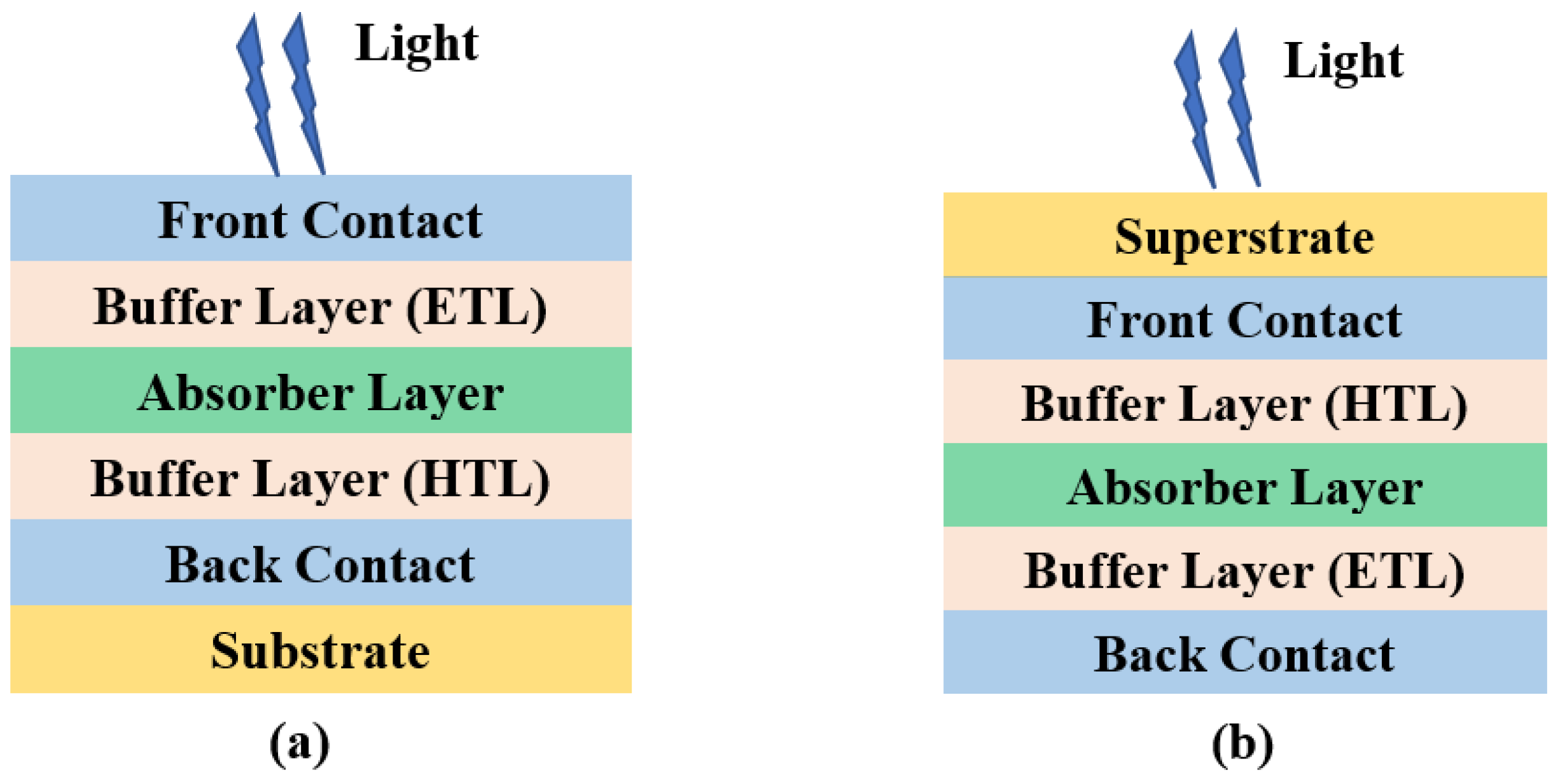
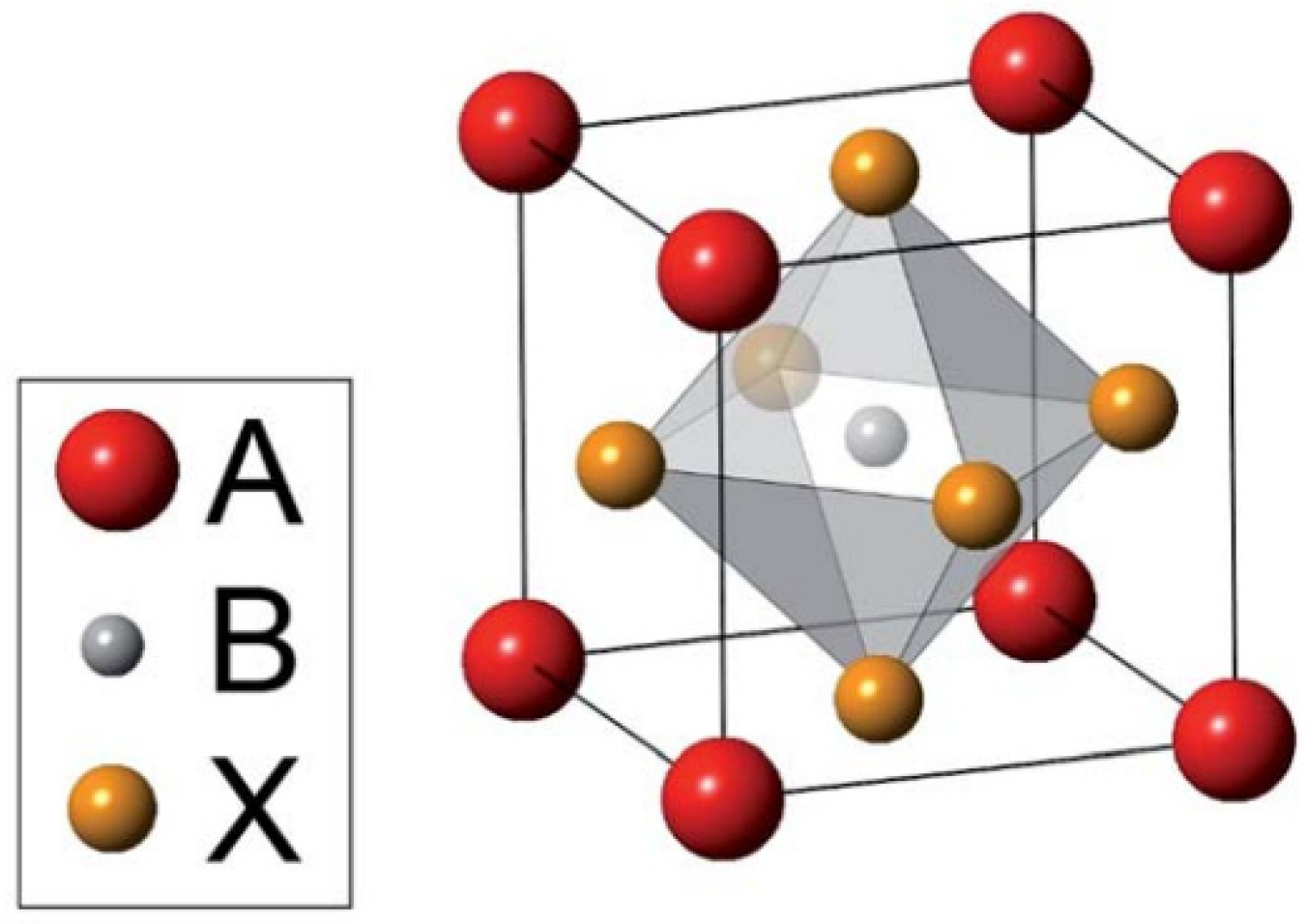


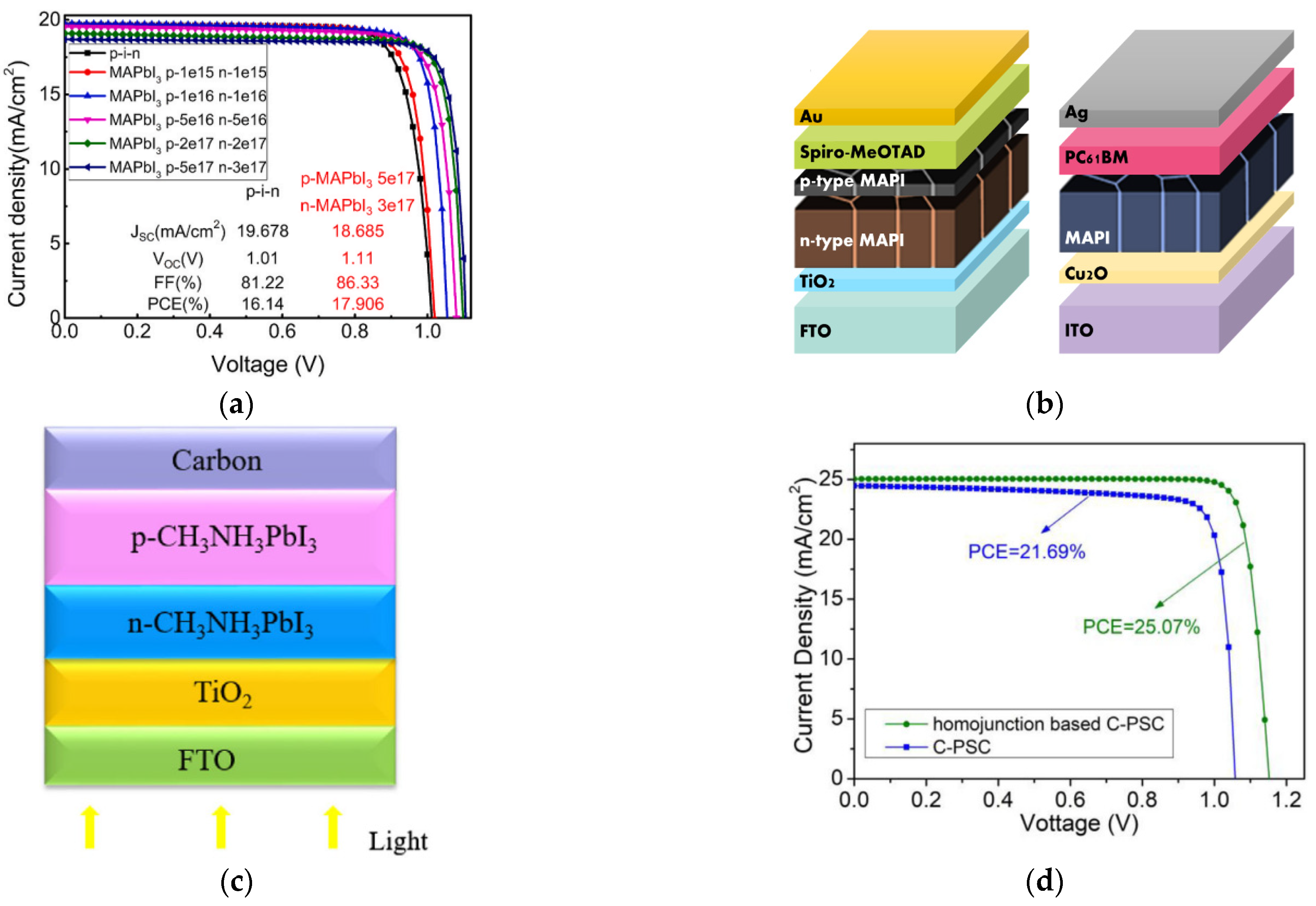

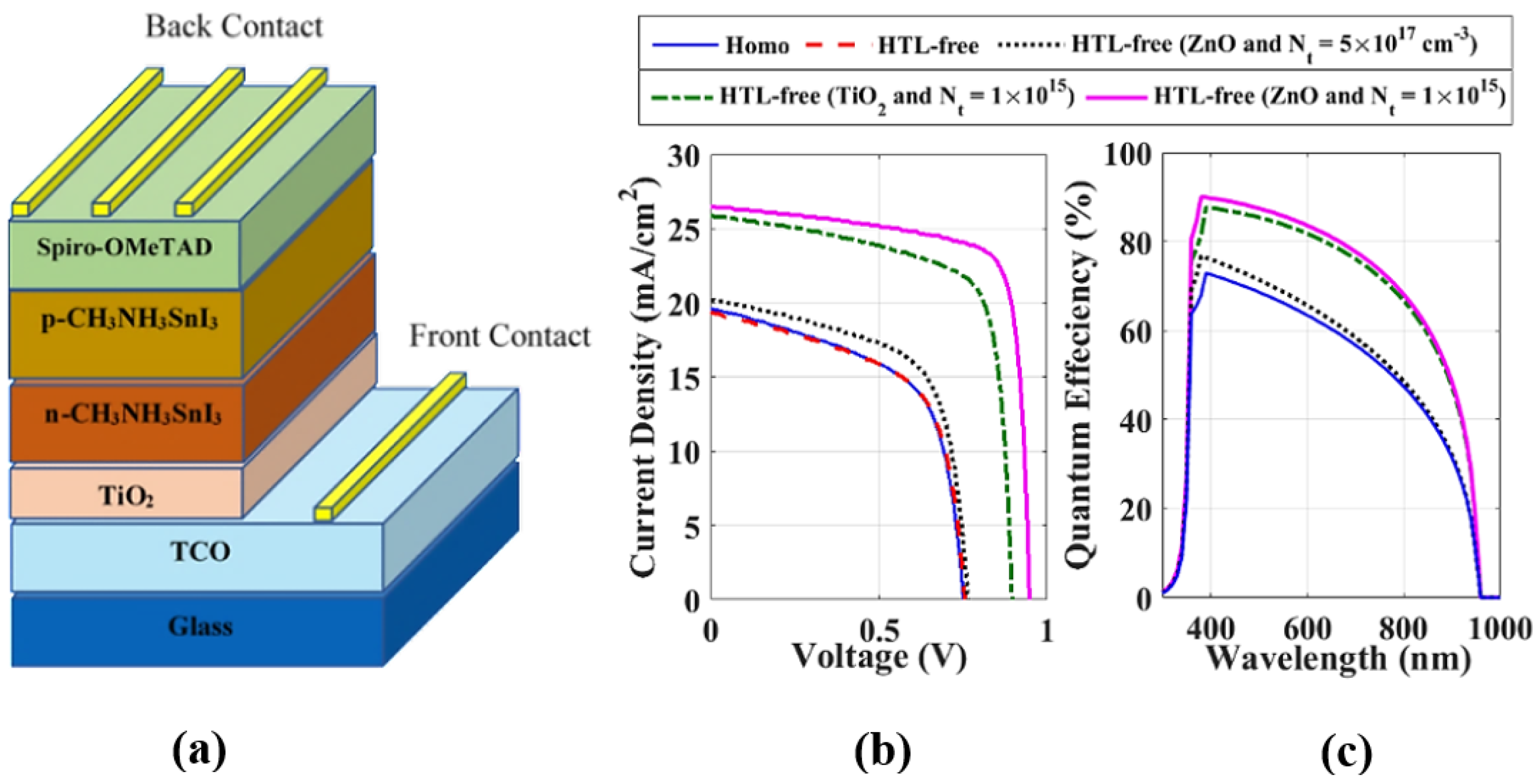


| Layer Type | Role | Requirements |
|---|---|---|
| Substrate/Superstrate | Mechanical and thermal stability | Transparency (superstrate) |
| Front Contact | Electrical contact | Transparent |
| Buffer Layers | Charge extraction, light trapping, antireflection | Good band alignment |
| Absorber | Absorbing light, charge extraction, | Low recombination, high mobility, low defects |
| Back Contact | Electrical contact | High reflection |
| Study | Structure | Method | VOC (V) | JSC (mA/cm2) | FF (%) | PCE (%) | Year |
|---|---|---|---|---|---|---|---|
| [85] | Conventional | Vacuum Deposition | 1.095 | 16.8 | 79.7 | 14.7 | 2018 |
| [96] | Conventional (MAPbI) | Combined Deposition | 1.13 | 23.86 | 77.5 | 20.8 | 2019 |
| Conventional (FAMAPbI) | 1.12 | 24.23 | 80.5 | 21.88 | |||
| CTL-free | --- | --- | --- | 8.08 | |||
| [97] | Conventional (MAPbI) | Two-solution Deposition | 1.00 | 18.67 | 38.42 | 7.17 | 2019 |
| Conventional (MAPbI+0.04NaI) | 0.99 | 12.18 | 49.32 | 5.94 | |||
| Conventional (MAPbI+0.04KI) | 1.01 | 16.58 | 45.58 | 7.63 | |||
| Conventional (MAPbI+0.04RbI) | 1.02 | 18.78 | 35.83 | 6.85 | |||
| [98] | Conventional | Spin-coating | --- | --- | --- | --- | 2020 |
| [99] | Conventional, Graded Pb/Sn | Simple three-step dynamic spin-coating | 1.14 | 25.9 | 72.6 | 21.4 | 2020 |
| ETL-free, Graded Pb/Sn | 1.11 | 25.3 | 66.1 | 18.7 | |||
| HTL-free, Graded Pb/Sn | 1.03 | 22.7 | 47.4 | 11.1 | |||
| CTL-free, Graded Pb/Sn | 0.89 | 23.6 | 49 | 10.3 | |||
| [100] | Conventional | Two-step spin-coating | 1.136 | 24.28 | 79.7 | 22 | 2020 |
| [101] | Conventional | 1.25 | --- | --- | 13.2 | 2021 | |
| [102] | Conventional | Spin-coating | 1.251 | 17.12 | 0.74 | 15.29 | 2021 |
| Study | Device Structure | VOC (V) | JSC (mA/cm2) | FF (%) | PCE (%) | Year |
|---|---|---|---|---|---|---|
| [108] | Au/Spiro-OMeTAD/p-MAPbI/n-MAPbI/TiO2/FTO | 1.14 | 25.85 | 77.94 | 23.52 | 2021 |
| [96] | FTO/TiO2/n-type/p-type/Spiro-OMeTAD/Au | 1.142 | 23.43 | 73.9 | 19.79 | 2019 |
| [109] | [Basic] Au/Spiro-OMeTAD/p-MAPbI/n-MAPbI/TiO2/FTO | 1.11 | 20.64 | 79.06 | 18.19 | 2021 |
| [Optimized] | --- | --- | --- | 27.1 | ||
| [110] | Al/ZnO/n-MAPbI/p-MAPbI/NiO/ITO | 1.11 | 18.685 | 86.33 | 17.9 | 2021 |
| [Optimized] | 1.093 | 20.185 | 86.56 | 19.1 | ||
| [111] | Ag/PC61BM/n-MAPbI/p-MAPbI/CuAlO2/ITO | 1.161 | 19.24 | 73.87 | 16.48 | 2021 |
| [112] | FTO/TiO2/n-MAPbI/p-MAPbI/Carbon | 1.15 | 25.03 | 86.89 | 25.07 | 2020 |
| [113] | CTL-free homojunction | 1.19 | 24.74 | 89.5 | 26.35 | 2022 |
| [114] | CTL-free homojunction | 0.8012 | 24.93 | 78.1 | 15.6 | 2022 |
| [115] | TCO/WS2/MAPbI3(n)/MAPbI3(p)/MoO3/Metal | 1.15 | 26.55 | 87.94 | 26.81 | 2021 |
| TCO/WS2/(Graded)MAPbI3(n)/MAPbI3(p)/MoO3/Metal | 1.164 | 27.606 | 87.89 | 28.26 | ||
| [129] | HTL-free (lead-free) | 0.948 | 26.48 | 77.2 | 19.37 | 2021 |
| Study | Material | Method | VOC (mV) | JSC (mA/cm2) | FF (%) | PCE (%) | Year |
|---|---|---|---|---|---|---|---|
| [131] | SnS | Sputtering deposition | 360 | 7.5 | 53 | 1.4 | 2021 |
| [130] | Sb2Se3 | Magentron sputtering combined with post-selenization treatment | 280 | 22.45 | 34.51 | 2.17 | 2021 |
| [10] | Sb2Se3 | Magentron sputtering | 294 | 20 | 41 | 2.41 | 2020 |
| [132] | SnS | Simulation (Standalone) | 410 | 26.75 | 69.45 | 7.62 | 2022 |
| Simulation (Optimized standalone) | 800 | ~33 | 85 | 23.3 | |||
| [1] | Sb2Se3 | Simulation (Hybrid homojunction with CdS as ETL) | 643 | 32.17 | 59.06 | 12.23 | 2022 |
| Simulation (Hybrid homojunction with ZnOS as ETL) | 707 | 33.29 | 70.13 | 16.51 | |||
| Simulation (Homojunction with No ETL) | 671 | 27.61 | 67.87 | 12.58 |
| Challenge | Reason | Suggested Solution |
|---|---|---|
| Loss of uniformity for large-sized solar cell fabrication | Deposition techniques are not efficient | Investigating substitution methods for depositing PVK TFSC layers |
| PVK layers have high defect density | High doping concentrations | Discovering more proper PVK self-doping and extrinsic doping approaches |
| Severe interfacial recombination | Removal of the ETL and HTL, and direct contact between electrode and PVK layer. | Optimize the device with interfacial engineering and defect passivation |
| PVK solar cells short operational lifetime under environmental conditions | - Defects on crystal structure - Reactivity between adjacent layers - Sensitivity to moisture, oxygen, ultraviolet radiation - High temperatures | Material engineering, novel device structure design, electrode materials, encapsulation method |
Disclaimer/Publisher’s Note: The statements, opinions and data contained in all publications are solely those of the individual author(s) and contributor(s) and not of MDPI and/or the editor(s). MDPI and/or the editor(s) disclaim responsibility for any injury to people or property resulting from any ideas, methods, instructions or products referred to in the content. |
© 2023 by the authors. Licensee MDPI, Basel, Switzerland. This article is an open access article distributed under the terms and conditions of the Creative Commons Attribution (CC BY) license (https://creativecommons.org/licenses/by/4.0/).
Share and Cite
Saif, O.M.; Elogail, Y.; Abdolkader, T.M.; Shaker, A.; Zekry, A.; Abouelatta, M.; Salem, M.S.; Fedawy, M. Comprehensive Review on Thin Film Homojunction Solar Cells: Technologies, Progress and Challenges. Energies 2023, 16, 4402. https://doi.org/10.3390/en16114402
Saif OM, Elogail Y, Abdolkader TM, Shaker A, Zekry A, Abouelatta M, Salem MS, Fedawy M. Comprehensive Review on Thin Film Homojunction Solar Cells: Technologies, Progress and Challenges. Energies. 2023; 16(11):4402. https://doi.org/10.3390/en16114402
Chicago/Turabian StyleSaif, Omar M., Yasmine Elogail, Tarek M. Abdolkader, Ahmed Shaker, Abdelhalim Zekry, Mohamed Abouelatta, Marwa S. Salem, and Mostafa Fedawy. 2023. "Comprehensive Review on Thin Film Homojunction Solar Cells: Technologies, Progress and Challenges" Energies 16, no. 11: 4402. https://doi.org/10.3390/en16114402
APA StyleSaif, O. M., Elogail, Y., Abdolkader, T. M., Shaker, A., Zekry, A., Abouelatta, M., Salem, M. S., & Fedawy, M. (2023). Comprehensive Review on Thin Film Homojunction Solar Cells: Technologies, Progress and Challenges. Energies, 16(11), 4402. https://doi.org/10.3390/en16114402








